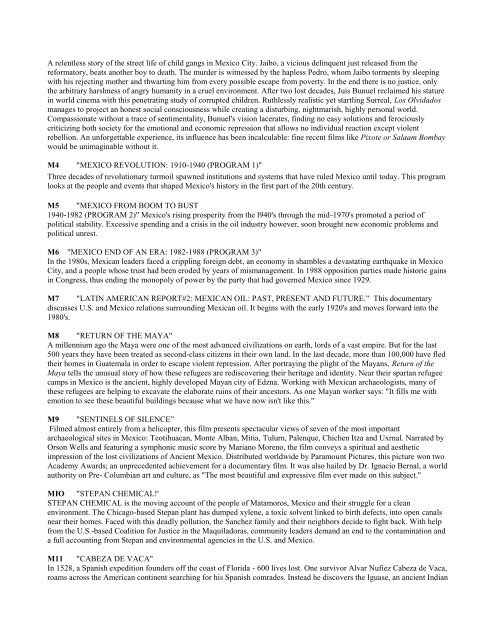Center for Latin American and Caribbean Studies
Center for Latin American and Caribbean Studies
Center for Latin American and Caribbean Studies
You also want an ePaper? Increase the reach of your titles
YUMPU automatically turns print PDFs into web optimized ePapers that Google loves.
A relentless story of the street life of child gangs in Mexico City. Jaibo, a vicious delinquent just released from the<br />
re<strong>for</strong>matory, beats another boy to death. The murder is witnessed by the hapless Pedro, whom Jaibo torments by sleeping<br />
with his rejecting mother <strong>and</strong> thwarting him from every possible escape from poverty. In the end there is no justice, only<br />
the arbitrary harshness of angry humanity in a cruel environment. After two lost decades, Juis Bunuel reclaimed his stature<br />
in world cinema with this penetrating study of corrupted children. Ruthlessly realistic yet startling Surreal, Los Olvidados<br />
manages to project an honest social consciousness while creating a disturbing, nightmarish, highly personal world.<br />
Compassionate without a trace of sentimentality, Bunuel's vision lacerates, finding no easy solutions <strong>and</strong> ferociously<br />
criticizing both society <strong>for</strong> the emotional <strong>and</strong> economic repression that allows no individual reaction except violent<br />
rebellion. An un<strong>for</strong>gettable experience, its influence has been incalculable: fine recent films like Pixote or Salaam Bombay<br />
would be unimaginable without it.<br />
M4 "MEXICO REVOLUTION: 1910-1940 (PROGRAM 1)"<br />
Three decades of revolutionary turmoil spawned institutions <strong>and</strong> systems that have ruled Mexico until today. This program<br />
looks at the people <strong>and</strong> events that shaped Mexico's history in the first part of the 20th century.<br />
M5 "MEXICO FROM BOOM TO BUST<br />
1940-1982 (PROGRAM 2)" Mexico's rising prosperity from the l940's through the mid-1970's promoted a period of<br />
political stability. Excessive spending <strong>and</strong> a crisis in the oil industry however, soon brought new economic problems <strong>and</strong><br />
political unrest.<br />
M6 "MEXICO END OF AN ERA: 1982-1988 (PROGRAM 3)"<br />
In the 1980s, Mexican leaders faced a crippling <strong>for</strong>eign debt, an economy in shambles a devastating earthquake in Mexico<br />
City, <strong>and</strong> a people whose trust had been eroded by years of mismanagement. In 1988 opposition parties made historic gains<br />
in Congress, thus ending the monopoly of power by the party that had governed Mexico since 1929.<br />
M7 "LATIN AMERICAN REPORT#2: MEXICAN OIL: PAST, PRESENT AND FUTURE.” This documentary<br />
discusses U.S. <strong>and</strong> Mexico relations surrounding Mexican oil. It begins with the early 1920's <strong>and</strong> moves <strong>for</strong>ward into the<br />
1980's.<br />
M8 "RETURN OF THE MAYA"<br />
A millennium ago the Maya were one of the most advanced civilizations on earth, lords of a vast empire. But <strong>for</strong> the last<br />
500 years they have been treated as second-class citizens in their own l<strong>and</strong>. In the last decade, more than 100,000 have fled<br />
their homes in Guatemala in order to escape violent repression. After portraying the plight of the Mayans, Return of the<br />
Maya tells the unusual story of how these refugees are rediscovering their heritage <strong>and</strong> identity. Near their spartan refugee<br />
camps in Mexico is the ancient, highly developed Mayan city of Edzna. Working with Mexican archaeologists, many of<br />
these refugees are helping to excavate the elaborate ruins of their ancestors. As one Mayan worker says: "It fills me with<br />
emotion to see these beautiful buildings because what we have now isn't like this."<br />
M9 "SENTINELS OF SILENCE”<br />
Filmed almost entirely from a helicopter, this film presents spectacular views of seven of the most important<br />
archaeological sites in Mexico: Teotihuacan, Monte Alban, Mitia, Tulurn, Palenque, Chichen Itza <strong>and</strong> Uxrnal. Narrated by<br />
Orson Wells <strong>and</strong> featuring a symphonic music score by Mariano Moreno, the film conveys a spiritual <strong>and</strong> aesthetic<br />
impression of the lost civilizations of Ancient Mexico. Distributed worldwide by Paramount Pictures, this picture won two<br />
Academy Awards; an unprecedented achievement <strong>for</strong> a documentary film. It was also hailed by Dr. Ignacio Bernal, a world<br />
authority on Pre- Columbian art <strong>and</strong> culture, as "The most beautiful <strong>and</strong> expressive film ever made on this subject."<br />
MIO "STEPAN CHEMICAL!'<br />
STEPAN CHEMICAL is the moving account of the people of Matamoros, Mexico <strong>and</strong> their struggle <strong>for</strong> a clean<br />
environment. The Chicago-based Stepan plant has dumped xylene, a toxic solvent linked to birth defects, into open canals<br />
near their homes. Faced with this deadly pollution, the Sanchez family <strong>and</strong> their neighbors decide to fight back. With help<br />
from the U.S.-based Coalition <strong>for</strong> Justice in the Maquiladoras, community leaders dem<strong>and</strong> an end to the contamination <strong>and</strong><br />
a full accounting from Stepan <strong>and</strong> environmental agencies in the U.S. <strong>and</strong> Mexico.<br />
M11 "CABEZA DE VACA"<br />
In 1528, a Spanish expedition founders off the coast of Florida - 600 lives lost. One survivor Alvar Nufiez Cabeza de Vaca,<br />
roams across the <strong>American</strong> continent searching <strong>for</strong> his Spanish comrades. Instead he discovers the Iguase, an ancient Indian



